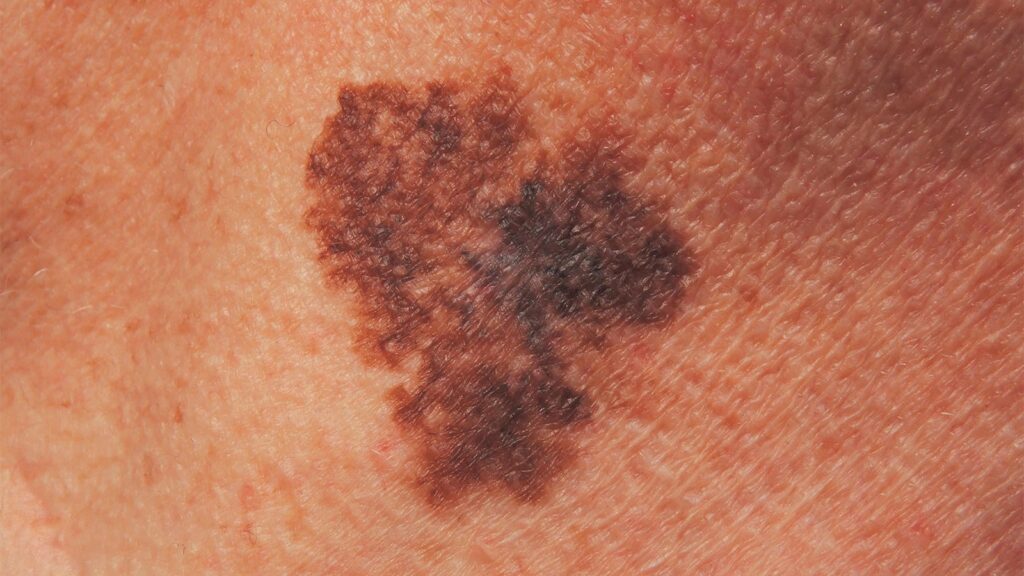Wide local excision with a 5-mm margin for smaller melanomas in situ (MISs) may be appropriate for sites at low risk of recurrence, Australian researchers suggested, despite recent guidelines recommending margins of up to 1 cm.
Their retrospective case series of small MISs (6 × 5 mm on average) excised with a 5-mm margin showed that 99.1% had no clinical recurrence after at least 5 years of follow-up. The three lesions that did recur were all local recurrences and were re-excised with clear margins, reported Cong Sun, MD, of Mater Hospital Brisbane Raymond Terrace in South Brisbane, and colleagues.
Of note, most of the lesions (71%) had undergone an initial excisional biopsy with a 2- to 3-mm margin, while the remaining underwent shave biopsy, with the goal being removal of the entire lesion, according to the finding in JAMA Dermatology.
The recurrence rate of 0.9% with no regional or distal metastasis is comparable to that reported with Mohs micrographic surgery using excisional margins between 6-12 mm (0.26-1.1%), the researchers said.
“This shows that using a 5-mm margin for MIS of smaller size (1 cm), low-risk lesions on the trunk and extremities may require 1-cm margins and still offer local recurrence rates of about 2%,” he continued. “For MIS lesions that are at high risk for recurrence because of poorly defined margins, a recurrent nature, or being amelanotic in color, of a larger size, or located on the head, neck, hands, feet, or genitalia, Mohs surgery with immunostaining of the margins can potentially minimize recurrence and reduce morbidity and mortality of MIS.”
The case series from Sun and colleagues examined 351 small MISs from 292 patients (mean 60 years; 56% female) treated with 5-mm wide local excision at a single private dermatology clinic in Australia from January 2011 to November 2018.
Patients needed to have 5 years of follow-up and lesions were excluded if they had initially required more than one wide local excision. Most of the excisions were performed by a general practitioner (63%), with the rest done by a dermatologist.
More than three-fourths (78%) of the lesions were smaller than 10 mm in length and 89% were smaller than 10 mm in width (median length 6 mm, range 2-21 mm; median width 5 mm, range 2-14 mm).
Superficial spreading was the most common MIS subtype (50.4%), followed by lentigo maligna (31%) and lentiginous MIS (19%). Most lesions were located on the trunk (48%) or extremities (upper limb, 27%; lower limb, 17%), with 7% located on the neck or face and 0.6% on the scalp.
Six lesions (1.7%) required a second wide local excision “to achieve adequate histologic margins,” said Sun and co-authors, but no patients required adjuvant imiquimod or radiotherapy following excision.
Beyond the single-center design and retrospective nature of the study, other limitations cited by the authors included the predominantly small lesion sizes and that biopsy margin pattern for pigmented lesions may not be the same in Australia as in the U.S.
Kate Kneisel is a freelance medical journalist based in Belleville, Ontario.
Disclosures
The study authors and editorialist reported no conflicts of interest.
Primary Source
JAMA Dermatology
Source Reference: Cong S, et al “Recurrence rate of small melanoma in situ on low-risk sites excised with 5-mm excisional margin” JAMA Dermatol 2024; DOI: 10.1001/jamadermatol.2024.1878.
Secondary Source
JAMA Dermatology
Source Reference: Zitelli JA “Recurrence rate of melanoma in situ excised with a 5-mm excisional margin” JAMA Dermatol 2024; DOI: 10.1001/jamadermatol.2024.1877.
>>> Read full article>>>
Copyright for syndicated content belongs to the linked Source : MedPageToday – https://www.medpagetoday.com/dermatology/skincancer/110980
